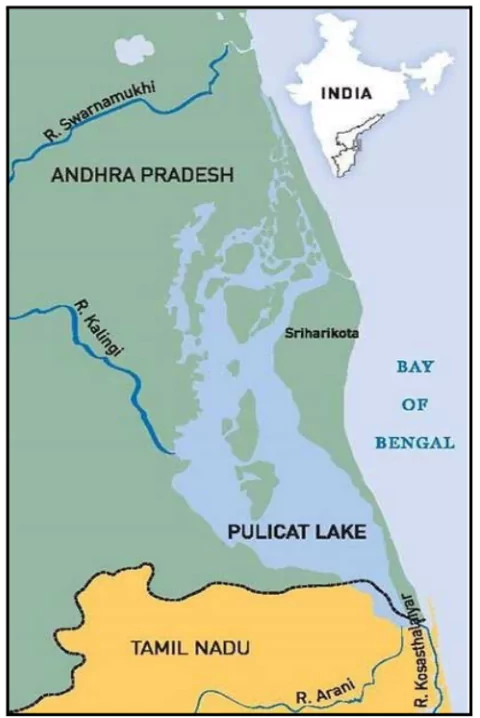Flamingos have returned to Pulicat Lake near Sriharikota, Andhra Pradesh, with the onset of the northeast monsoon.
About Flamingos
- Flamingos are large shorebirds with S-shaped long necks and stick-like legs.
- There are six species of flamingos worldwide:
Enroll now for UPSC Online Classes
| Species |
Distribution |
IUCN Status |
Distinctive Features |
| Greater Flamingo (Phoenicopterus roseus) |
Africa, Europe, and Asia |
Least Concern |
Largest flamingo species, pale pink plumage |
| Chilean Flamingo (Phoenicopterus chilensis) |
South America |
Least Concern |
Similar to Greater Flamingo but with a darker pink hue |
| American or Caribbean Flamingo (Phoenicopterus ruber) |
Caribbean, South America, and Florida |
Near Threatened |
Bright pink plumage, long, slender neck |
| Lesser Flamingo (Phoeniconaias minor) |
Africa and India |
Near Threatened |
Smallest flamingo species, bright pink plumage |
| Andean Flamingo (Phoenicoparrus andinus) |
Andes Mountains in South America |
Vulnerable |
Yellow legs and feet, red spot between nostrils |
| James’s or Puna Flamingo (Phoenicoparrus jamesi) |
Andes Mountains in South America |
Endangered |
All-black flight feathers, unique bill shape |
- Distribution: Found in tropical and subtropical regions globally.
- Indicator Species: The flamingoes are the indicators of a healthy coastal environment.
- They play a vital role in maintaining the delicate balance of wetland ecosystems.
- Types of Flamingoes found in India: Two species are commonly found.
- Greater Flamingo
- Lesser Flamingo
About Greater Flamingo (Phoenicopterus roseus)

- It is the most widespread and largest flamingo species.
- Distinguished by black-tipped light pinkish beaks, yellowish eyes, and pinkish-white bodies.
- Taller compared to other species.
- State Symbol: Recognized as the state bird of Gujarat.
- Distribution: Found in Africa, the Indian subcontinent, the Middle East, and southern Europe.
- In India, they are present across most regions except high-altitude Himalayas, East, and Northeast India.
- Habitat: Inhabit both brackish and freshwater wetlands.
- Conservation Status
- IUCN: Listed as Least Concern.
- CITES: Included in Appendix II.
About Lesser Flamingo (Phoeniconaias minor)

- They are the smallest among all flamingo species.
- Unique for possessing a “hallux” or hind toe, which is absent in some other flamingo species.
- Males are slightly taller than females.
- Habitat: Found in coastal and inland wetlands.
- Diet: They primarily feed on blue-green algae but also consume crustaceans and small insects occasionally.
- Distribution: Largely restricted to western India in brackish water regions such as Gujarat, Rajasthan, and Mumbai.
- Conservation Status
- IUCN: Classified as Near Threatened.
- CITES: Included in Appendix II.
Check Out UPSC NCERT Textbooks From PW Store
About Pulicat Lake

- Pulicat Lake is India’s second-largest brackish water ecosystem, following Chilika Lake in Odisha.
- It was designated as a Ramsar site in 2002.
- It runs parallel to the Bay of Bengal and has a sandbar, making it a unique lagoon ecosystem.
- Water Sources: The lake is fed by three rivers:
- Arani River: At its southern tip.
- Kalingi River: From the northwest.
- Swarnamukhi River: At the northern end.
- Location: Pulicat Lake lies on the border of Andhra Pradesh and Tamil Nadu, with the majority of the lake situated in Andhra Pradesh.
- Bird Diversity: The lake attracts a variety of birds, including grey pelicans and painted storks, which visit annually.
Additional Reading: Pulicat Bird Sanctuary
![]() 6 Dec 2024
6 Dec 2024





